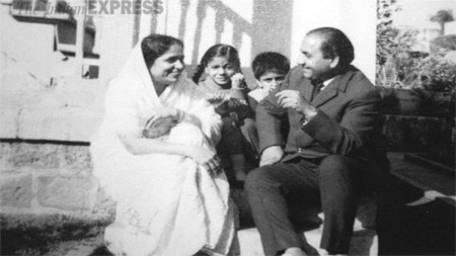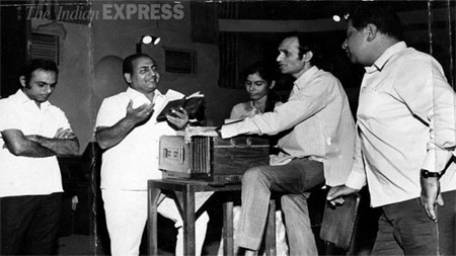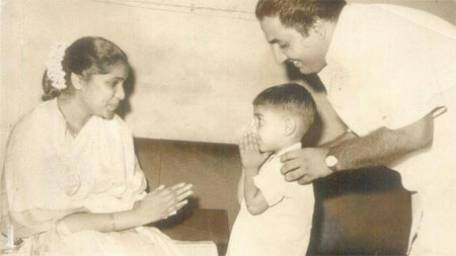Muhammad Rafi — full throat, tuneful, versatile singer — Part VII , VIII , IX
Dr Amjad Parvez

The last we saw of the quartet together was in the 1968 movie ‘Sanghursh’. The movie was about thugs in Varanasi. The story was based on Jnanpith Award winner Mahasweta Devi. It starred Dilip Kumar and Vyjantimala. Muhammad Rafi’s song “Jab dil sei dil takrata hai” was a melodious number. So was “Ishq diwana, husn bhi ghaail”. Dilip’s rustic dance was mesmerising in “Mere pairon mein ghungroo”. Biman Baruah in his submission on Rafi and Naushad Ali’s relations observed that in 1952, the songs of the movie ‘Baiju Bawra’ established Rafi as the number one playback singer of Indian cinema. It is said that Talat Mahmood used to be Naushad Ali’s favourite singer until then and once he found Talat Mahmood smoking in recording room. Naudhad Ali got irritated and hired Rafi to sing for ‘Baiju Bawra’. Later on, Naushad started using Rafi as a male voice in almost every song composed by him. In fact, Naushad found a singer in Rafi, who was capable of singing all type of songs of his compositions almost perfectly.
It has been reported in the media that cracks appeared in the Dilip-Naushad-Rafi team when Rafi felt demoralised when Dilip Kumar once invited only Naushad to travel in his car to a function where Rafi was due to perform, with Dilip and Naushad presiding over it. This offended Rafi, who stopped singing for Dilip Kumar, who then used the vocals of Mohinder Kapoor and Kishore Kumar in his subsequent movies.
Association with SD Burman: Versatility has been a common factor between Rafi as a singer and music composer SD Burman as a composer. The latter however gave equal share to both Kishore Kumar and Rafi as singers. In his later movies SD tilted more towards Kishore Kumar. Though SD used Rafi in the movie ‘Do Bhai’ in 1947 (“Duniya mein meri aj andhera hi andhera”, lyrics Raja Mehdi Ali Khan) this song has gone into oblivion. The best debut of Rafi by SD, I would reckon however is a decade later in Guru Dutt’s movie ‘Pyasa’. Rafi’s softness of expression and climax rendering in higher notes was best used in the song ‘Ye mehlon yei takhton”. In the song the redeeming feature is that one finds a rare use of a film song with tilt towards poetics. Sahir’s poetry has been blunt, forceful and hard-hitting in this song. SD Burman’s craftsmanship is at its top as music composer in this song. Despite very few instruments used in this song Rafi has proved that none other than him could have done justice to this composition. The critics say that in the climax of the movie, Guru Dutt (poet Vijay) walks in the auditorium where the cynical publisher Rahman, who had trashed his poetry (posing it to be his) and also married his beloved, Mala Sinha, is presiding over his (poet Vijay) Barsi (first death anniversary), eulogising him as his collection of poems has become a roaring success for his publishing house. The so-called ‘dead’ poet standing under the door frame with the director Guru Dutt’s signature play with light and shade and his singing/reciting this nazm, which makes the audience turn their heads, and the ‘dignitaries’ on the dais, including Rahman and Mala Sinha, stare in stunned disbelief, is a piece of art in many respects. All this impact is enhanced by Rafi-SD-Sahir Ludhyanvi troika. For this movie Rafi’s romantic tone is best used with Geeta Dutt in the duet “Hum aap ki aankhon main is dil ko”, satire in his voice in the song “Jinhain naaz hei hind par”, comedy at its peak in the song “Sir jo tera chakraei ya dil dooba jaye” picturised on Johnny Walker. These songs enhance the versatility factor of the pair. The other songs from this movie by Rafi are “Yei hanste huey phool” and “Jab hum chalain tau saath hamara saaya”. All these songs were penned by Sahir Ludhyanvi.
From 1947 to 1957 SD used Hement Kumar, Talat Mahmood, Kishore Kumar and even Mukesh sporadically. In the initial phase of his career, the question of SD’s preference of Rafi over Kishore Kumar could best be answered by SD himself had he been alive today but the statistics given by Arun Kumar Deshmukh on Atul Site are to the contrary; 44 solo song by Rafi and 52 solo songs in Kishore Kumar’s favour. However the analysis of music lovers is that if a sculptor SD had crafted these songs with great concern, Rafi put soul into them with equal feelings. SD Burman’s craftsmanship knew the film situations where he could use Rafi’s tenor to his advantage. After 1957, SD extracted gems after gems for the movies ‘Kala Pani (1958), ‘Insan Jaag Utha’, ‘Kagaz Ke Phool’ (1959), ‘Bambai Ka Babu’ (“Diwana Mastana Hua Dil, Jane Kahan Ho Kei Bahar Aai), Kala Bazar (1960), Meri Surat Teri Ankhen, Tere Ghar Ke Samne (1963), Guide, Teen Deviyan (1965) and so on.
From : Daily Times March 02, 2014
Part VI

Dr Amjad Parvez
Even after post ‘Aradhna’ (1969) era, when Kishore Kumar had gained popularity, SD Burman kept on using Muhammad Rafi’s talent until the very end.
Rafi’s voice is used wonderfully well by SD for ghazal rendering also. Although Khayyam and Madan Mohan are considered the best in this domain of art, both SD’s two representative numbers in this domain of singing are first of all; “Hum bekhudi mein tum ko” from the movie ‘Kala Pani’ (1958) picturised on Dev Anand. (It is a standard example of SD’s craftsmanship. This song has a special pedigree, as it is based on SD Burman’s Bengali song “Ghum Bbhulechhi” (“I stay awake all alone in this night”).
SD Burman’s singing style is very different from a conventional film song, but he adapts it beautifully to this scene where a dejected Dev Anand drowns his sorrows in alcohol, while the sympathetic courtesan, Nalini Jaiwant dances indulgently. Her sitting dancing mujra is a deviation from the usual dancing steps and loud music. Rafi stretches each and every word with emotion and tunefulness with special emotions in his rendering. SD has created masterpieces with minimal orchestra. Rafi’s command over his voice shows his mastery on such songs). The second worth mentioning song is “Kahin bekhayal ho kar” from the movie ‘Teen Deviyan’ (1965) with lyrics by Majrooh Sultanpuri. Beauty of this song is its seven beat rhythms, use of flute and santoor in interval pieces. Another gem from this Bimal Roy movie is “Dil main ik jan-e-tamana”. Since this movie was a less acclaimed movie of Bimal Roy, one can close one’s eyes and imagine Dev Anand singing these songs rather than Shashi Kapoor.
After the success of Guru Dutt’s movie ‘Pyaasa’, Dutt went for another venture ‘Kagaz Ke Phool’ but not commercially successful this time. Many cinema lovers still recognise this movie greater than ‘Pyaasa’.
Themes of these had certain commonality in the sense that the main figures in these movies were an actor and a film director respectively. Both have to face the selfish and cynical world, which values commercial success more than inherent values. Some critics say that it was an autobiography of Dutt and many rate this movie as one of the greatest classics. As Sinha (Guru Dutt), once famous, now a ‘failed’ director, surveys the ruins of his studio from the scaffolding, his inner despondency and frustration is reflected in this moody song by Rafi with excellent poetry by Kaifi Azmi (actress Shabana Azmi’s father). The song is “Daikho zamane ki yaari”. The ritual of using minimum orchestra was replicated by SD in this movie. It is because when one creates a masterpiece; one is hesitant to use too many colours to confuse the creation as doing so would distract the art lover from the beauty of the statuette. The song later diffuses into flashback of his glorious days when he was mobbed by admiring fans, scrambling for his autograph, swaying now to a fast chorus with completely different words; another masterpiece of Dutt’s fascination with light and shades.
Rafi again excelled in Dev Anand’s 1965 movie ‘Guide’ with the soft songs “Din dhal jeye” (lyrics by Shailender) and “Tere mere sapne sab aik rang hain”. These songs are acclaimed masterpieces of Navketan films. Dev Anand and Waheeda Rehman’s acting was at their top, so was Vijay Anand’s direction. SD’s music for the song “Aj phir jeene ki tamana hei” is one of the best Lata-Kishore Kumar’s songs and Waheeda’s acting. It was a pity that ‘Guide’ music was not given Filmfare award that year and SK’s ‘Suraj’ was preferred instead. Many believe that SK would themselves have been embarrassed on SD being ignored that year for the award. Rafi’s song “Kya se kya ho gya” uses Rafi’s full throat singing amicably well. In another Navketan movie 1960 movie ‘Kala Bazar’ Rafi and SD were at their best in the song “Khoya khoya chand, khula asman”. This song depicts varied shades of the great romantic hero Dev Anand in another successful venture.
The next worth mentioning songs is “Nache mun mora magan” from the movie ‘Meri Surat Teri Ankhen’ (1963) with lyrics by Shailender. It was a semi-classical number with special emphasis on tabla playing. SD’s training in classical music is exhibited in this song. Rafi’s proficient singing on ugly looking Ashok Kumar and Asha Parekh’s dance on the stage is marvellous. Rafi’s soft rendition is especially exhibited in the song “Tu kahan yei bata is nasheeli raat main” (lyrics Hasrat Jaipuri) from the 1963 movie ‘Tere Ghar Kei Samney’. This song was again picturised on Dev Anand who was famous for his songs with slight tilt of his head. Another song “Dil ka bhanwer kare pukar” from this movie is one of my favourites. Dev Anand sings this song while climbing the stairs of a minaret for Nutun; lovely piece of acting by both on the Hasrat Jaipuri penned song.
From : Daily Times March 03, 2014
Part IX

Dr Amjad Parvez
The humming at the end of every first line is lilting. The song “Tere ghar ke samney ik ghar” was also condensing for this movie of the same title. On a lilting mood I must quote the song “Janey kaya mera dil ab kahan kho gaya” from the movie ‘Ziddi’ made in 1964. This song was penned by Hasrat Jaipuri for this Parmod Chakarvarti picture. It starred Joy Mukherjee, Asha Parekh, Shobha Khote, Mahmud, Ulhas, Dhumal, Raj Mehra, Sulochana, Nazima and Mumtaz Begum.
Association with Roshan: I shall now shift to Roshan Laal, a melodious composer who composed outstanding, melodies in general and for Muhammad Rafi in particular. A song that immediately comes into mind is Suman Kalyanpur (her singing makes one feel that we are not missing Lata in this song) with Rafi in the duet “Aise tau na daikho keh behek jayen”. Picturised on Meena Kumari and Pardeep Kumar for the movie ‘Bheegi Raat’ in open air with picturesque flowery backdrop, the impact of the melody is further enhanced. 1961 movie ‘Arti’ was another milestone in the duo’s teamwork in the shape of the song “Ab kaya misaal dun”. This Meena Kumari-Pardeep Kumar movie was a musical hit. Lyrics were penned by Majrooh Sultanpuri. Roshan’s use of sitar, flutes and string instruments was very eastern especially while composing ghazals. This is a very soft melody. Another beauty from this movie is Lata-Rafi duet “Aap nei yaad dilaya tau mujhe yaad aaya”. The same melodious treatment is seen in 1967 movie ‘Bahu Begum’ with the same leading pair and the song is “Hum intizar karain gei tera”. Another song “zindigi kei more par jo koi raasta mila” from the movie ‘Bedagh’ catches my melodic-ears whenever I listen to it. The hallmark in Rafi-Roshan combination is “Jo baat tujh main hei teri tasveer main nahi” from the movie ‘Taj Mahal’ starring Pardeep Kumar and Bina Roy. In that era Kings used to sing to their beloved’s photographs. Another song with Lata from this movie “Paaon chu laine do” is a lilting number. Who can forget Lata-Rafi singing “Jo wada kiya hei nibhana pare ga” from this movie!
Earlier in 1954, Rafi sang “Zameen bhi wohi hei wohi asman” for the movie ‘Chandni Chowk’. Piano effects are used in this song to depict the degradation of Delhi’s society and devastation of the ancient city. This movie starred Shekhar and Meena Kumari. Rafi and Lata rendered “Buhut asaan hei chilman sei” for the 1956 movie ‘Rangeen Raatein’. This Kidar Sharma directed movie starred Shammi Kapoor, Geeta Bali and Mala Sinha. In 1960, Rafi sang a motivational song “Jan hatheli par lei kar phirte” for the movie ‘Laal Qilla’. It was a qawwali beat number using ‘Heer’ tune in Raag Bharvin for the ‘antaras’. Qawwali beat was Roshan’s forte like in the songs “Haseeno ke jalwe pareeshan rehte” for the 1961 movie ‘Baber’ by Rafi-Manna Dey and some female artists. For this movie Rafi rendered a song “Tum aik baar muhabbat ka imtihan”. Treatment given to this song was of ghazal type. This movie had B-class cast comprising Gajanan, Jagirdar, Salochna Chatterjee, Azra, etc. Romance and qawwali songs were epic in Roshan’s movie ‘Barsaat Ki Raat’ starring timeless beauty Madhubala and Bharat Bhushan. This romantic song was “Zindigi bhar nahi bhoole gi woh barsat ki raat”.
It is not that Roshan was expert in romantic and qawwali numbers only. His qawwalis from ‘Barsaat Ki Raat’ (“Na Tau Carvaan Ki Talash Hei”) and ‘Bahu Begum’ (Sahir Ludhyanvi’s “Arz-e-shauq ankhon main hei”) are all time hits. This qawwali was rendered by Manna Dey and Rafi for Meena Kumari and Pardeep Kumar. Roshan Laal could compose happy love songs too based on Punjabi folk. His composition “Duniya ki nazar hei buri zulfain” by Geeta Dutt and Rafi was happy romantic duet with a touch of Punjabi folk ‘Boliyan’ from the movie ‘Agra Road’ starring Vijay Anand, Shakeela and Nanda. Talking of romantic numbers with relatively fast beat, one can refer to the Asha-Rafi duet “In baharon main akele na phira karo” from the 1966 movie ‘Mamta’ with debonair Dharmendar and Suchitra Sen (who died recently at the time of writing this piece). In this song, violins play their interludes in cheerful countenance on the lyrics of Majrooh Sultanpuri. On a sad note, one cannot but refer to Rafi’s song “Carvan guzar geya ghubar daikhte rahe” from the film ‘Nai Umr Ki Nai Fasal’. On a happy and comic note, a song, “O! Daata hum ko bhi dei payara bangla” by Rafi and Asha from the 1958 movie ‘Aji Bus Shukriya’ can be referred to. A dance sequence on Western beat and instruments can be referred in the song from the film ‘Wallah Kaya Baat Hei’ with lyrics by Prem Dawan, picturised on Shammi Kapoor with Bina Roy as female lead and Nishi as side heroine.
From : Daily Times March 04, 2014